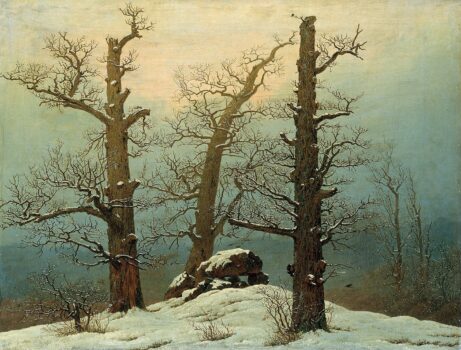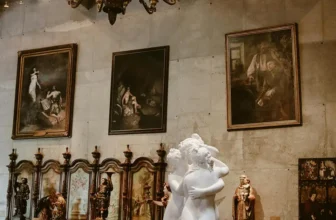Meaning of Dolmen in the Snow Painting
Caspar David Friedrich is widely regarded as one of the most significant figures in German Romantic painting. His works often blend landscape with emotional, spiritual, and philosophical depth, engaging with themes such as nature’s transcendence, death, solitude, and the divine. Among his less frequently discussed yet deeply evocative works is the painting known as “Dolmen in the Snow” (German: Hünengrab im Schnee). Painted in the early 19th century, this piece encapsulates Friedrich’s unique ability to bridge nature and mysticism through visual art.
Though the original painting has unfortunately been lost, believed to have been destroyed in the bombing of Dresden during World War II, its impact and significance remain enduring through photographs, preparatory sketches, and critical analysis. In this story post, we will delve into the history, meaning, symbolism, and artistic style of Dolmen in the Snow, unpacking its philosophical layers and artistic intent.
Who Was Caspar David Friedrich?
Born in 1774 in Greifswald, in Swedish Pomerania (now northeastern Germany), Friedrich was a deeply introspective figure who experienced personal tragedy early in life. The death of several of his siblings, including one who drowned before his eyes, profoundly shaped his outlook and later artistic expression. His paintings often reflect themes of loss, existential longing, and the search for spiritual meaning in the face of nature’s overwhelming power.
Friedrich became one of the leading figures of the Romantic movement, a counter-response to the Enlightenment’s focus on reason and rationality. Romanticism emphasized emotion, nature, the sublime, and the individual’s inner experience. Friedrich’s work was central to this shift, offering contemplative, often melancholic landscapes imbued with metaphysical overtones.
Who Painted Dolmen in the Snow, and How?
Dolmen in the Snow was painted by Caspar David Friedrich around 1807–1810, a critical period in his career when he was gaining recognition for redefining landscape painting. During this time, Friedrich moved away from conventional picturesque views to something far more conceptual and meditative.
Friedrich would begin with painstakingly detailed sketches made outdoors, sometimes walking for hours in forests, mountains, and along coastlines. He would then compose the final image in his studio, often combining different elements from various studies to create symbolic compositions that transcended literal representations of specific places.
The original Dolmen in the Snow was a medium-sized oil painting, though the exact dimensions and medium details have been lost. Surviving black-and-white photographs and sketches show a mysterious winter landscape dominated by a group of ancient stones surrounded by leafless, snow-laden trees, a scene both stark and timeless.
What Is a Dolmen?
A dolmen is a type of megalithic tomb, typically constructed from large upright stones supporting a horizontal capstone. These structures date back to the Neolithic period, around 4000–3000 BCE, and are found across Europe, particularly in Germany, France, the British Isles, and Scandinavia.
In folklore and Romantic imagination, dolmens were often associated with ancient druids, burial rites, and pre-Christian spiritual practices. To Friedrich and his contemporaries, the dolmen symbolized a connection to the deep past, a silent monument to human mortality and transcendence.
What Is Happening in Dolmen in the Snow?
In Dolmen in the Snow, we see a quiet, snow-covered forest. The trees are bare, their twisted branches stark against a pale sky. In the center stands the dolmen itself, three or more large stones forming a table-like structure, partially buried in snow. Around the dolmen are scattered broken branches and fallen logs, suggesting the passing of time, decay, and nature’s slow reclaiming of man-made monuments.
No human figures appear in the painting, a hallmark of many of Friedrich’s works. Instead, the landscape speaks for itself, inviting viewers into a state of contemplative solitude. The viewer becomes the lone observer, confronting the mysteries of the past, the silence of winter, and the inevitability of death.
This is not a painting about action or narrative. Rather, it is about presence and stillness, the dolmen as a silent witness to the passage of centuries, framed by a frozen natural world.
What Type of Art Is Dolmen in the Snow?
Dolmen in the Snow belongs firmly within the Romantic landscape tradition. But Friedrich pushed beyond traditional landscape painting by imbuing his scenes with symbolism, emotion, and philosophical depth. His works often explore the theme of the sublime, the awe-inspiring and sometimes terrifying beauty of nature that dwarfs human concerns.
Romanticism, as Friedrich practiced it, rejected the rationalism and scientific objectivity of the Enlightenment. Instead, it emphasized emotional intensity, individual experience, and spiritual searching. In this context, the dolmen becomes not merely an archaeological curiosity but a sacred relic, a symbol of the eternal, the unknown, and the divine.
Friedrich’s painting can also be seen through the lens of symbolic realism: while the trees, snow, and stones are meticulously rendered from nature, their arrangement and context serve a metaphysical purpose. The real becomes a gateway to the spiritual.
What Does Dolmen in the Snow Represent?
1. Mortality and Time
At its core, Dolmen in the Snow is a meditation on death, time, and memory. The dolmen, as an ancient burial site, immediately invokes the idea of human mortality. That it stands in a winter landscape, a season traditionally associated with death and dormancy, amplifies this theme.
The snow covering the dolmen may suggest forgetting or erasure, as if nature is slowly burying the memory of those long dead. But it may also signify peace and transcendence, a kind of eternal rest.
2. Nature’s Endurance
While the dolmen hints at human efforts to memorialize the dead, the surrounding trees and forest show the immensity and continuity of nature. The leafless trees, twisted and skeletal, suggest hardship and struggle, but also endurance.
Friedrich’s work often positions nature as a spiritual force, one that both dwarfs and redeems human existence. In this sense, the dolmen is both overwhelmed by nature and sanctified by it.
3. Spiritual Contemplation
Friedrich was a deeply spiritual man, though not traditionally religious in a doctrinal sense. His art reflects a belief that nature is a manifestation of the divine, a place for solitary reflection and spiritual encounter.
The dolmen, set in the middle of a stark winter forest, becomes a shrine or altar, inviting the viewer to pause and contemplate their own place in the cosmos. In the absence of a church or cross, the dolmen is a pagan temple, yet Friedrich treats it with profound reverence, suggesting that all sacred spaces, old or new, point toward the same existential truths.
Symbolism in Dolmen in the Snow
Friedrich’s symbolism is subtle, often requiring deep engagement with the image. Key symbolic elements in the painting include:
Dolmen: As mentioned, it is a symbol of death, memory, and human attempts at meaning-making across generations. It also evokes a pre-Christian spiritual worldview, connecting ancient religious consciousness with modern Romantic yearning.
Snow: Snow often symbolizes silence, purity, and stillness, but also obscurity and oblivion. In covering the dolmen, snow becomes a veil over history, suggesting how the past is concealed yet ever-present.
Bare Trees: Leafless and twisting, the trees represent life stripped of ornament, existence in its starkest form. They may symbolize the soul in winter: barren, waiting for renewal.
Light and Sky: Though not vividly colored in the surviving images, Friedrich often used light in the sky as a subtle symbol of divine presence. The faint brightness behind the trees hints at hope or transcendence.
Together, these elements create a painting that is less about what we see and more about what we feel and intuit.
Why Did Friedrich Paint the Dolmen?
The early 19th century saw a resurgence of interest in German nationalism, Romanticism, and the ancient past. Friedrich, while not overtly political, shared a fascination with Germany’s spiritual and cultural roots, particularly in its pre-Christian heritage.
Dolmens and other megalithic structures were seen by some Romantic thinkers as symbols of a primordial connection between man and nature, untouched by the rationalism of modernity or the institutional control of the Church. By painting a dolmen, Friedrich participates in this cultural discourse, offering a vision of ancient spirituality as a path to modern existential insight.
Where Is Dolmen in the Snow Located Today?
Tragically, the original Dolmen in the Snow was destroyed during World War II, most likely in the bombing of Dresden in 1945. It was once held in the Galerie Neue Meister, a major museum in Dresden that housed many of Friedrich’s works.
Although the painting is lost, it survives through black-and-white photographs and sketches made before the war. Art historians and museums have preserved these materials, and some have even attempted digital reconstructions based on Friedrich’s techniques and related works.
Thus, while we cannot see the original in person, Dolmen in the Snow lives on as a potent symbol in the canon of Romantic art, an emblem of Friedrich’s vision and the enduring power of symbolic landscape painting.
The Enduring Power of Dolmen in the Snow
Though lost to time, Dolmen in the Snow remains a powerful and evocative artifact of Romantic art and philosophy. It is not merely a painting of stones in the snow, but a window into the spiritual concerns of an age, questions of life and death, memory and time, nature and the divine.
Friedrich’s genius lies in his ability to take the ordinary, a stone monument, a snowy forest, and transform it into something transcendent. In Dolmen in the Snow, he offers us not only a landscape but a spiritual experience, a moment of quiet contemplation where we confront the mystery of our existence.
Even in absence, the painting compels us to pause, reflect, and listen to the silence of the snow.




